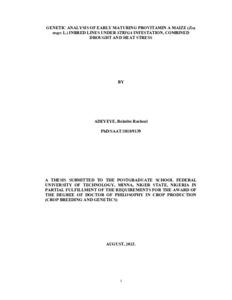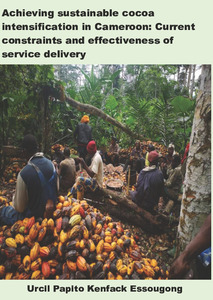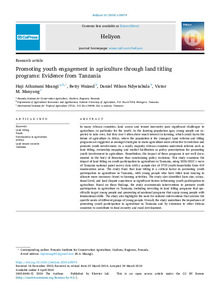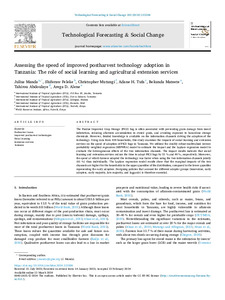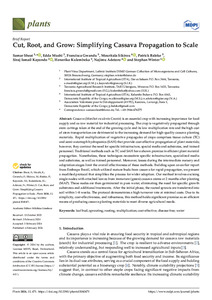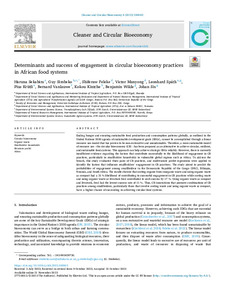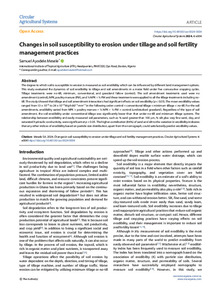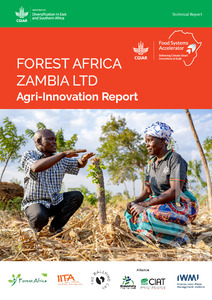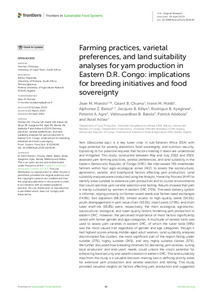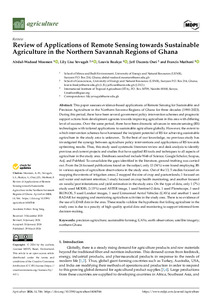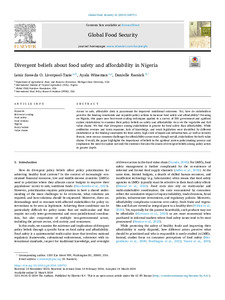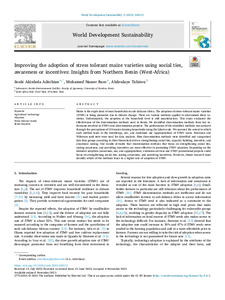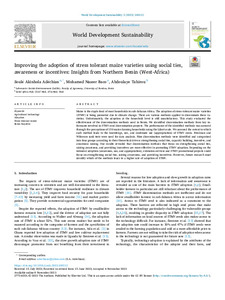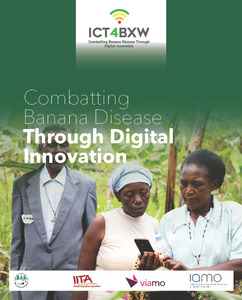Welcome to the International Institute of Tropical Agriculture Research Repository
IITA Bibliography System: Recent submissions
Now showing items 181-200 of 8094
-
Genetic analysis of early maturing provitamin A maize (Zea mays L.) inbred lines under Striga infestation, combined drought and heat stress
(Federal University of Technology Minna, 2023-08)High yielding and stable early maturing provitamin A (PVA) maize hybrids with combined stresses (drought and heat and Striga) tolerance are needed to combat malnutrition, low yield and insecurity in sub-Sahara Africa (SSA). To address this need, PVA, PVA-QPM (quality protein maize) inbred lines with Striga and drought tolerant genetic make-up were developed through the massive effort of the International Institute of Tropical Agriculture Maize Improvement Program (IITAMIP) for its hybrid ... -
Achieving sustainable cocoa intensification in Cameroon: current constraints and effectiveness of service delivery
(Wageningen University & Research, 2023-12-18)This thesis aims to increase our understanding of the current constraints to sustainable cocoa intensification in Cameroon and the extent to which service delivery in the sector is adequate. To this end, four levels of analysis are considered: farmers' perceptions of cocoa farming practices and ability to innovate; the socio-economic, socio-demographic, and farm factors that influence the intensity of adoption of cocoa best management practices (BMPs), cocoa yield, and net returns; the availability ... -
Farmer perspectives on desired catfish attributes in aquaculture systems in Nigeria. An exploratory focus group study
(2024-04-02)As a first step to determine the focus of potential genetic improvement programs for African catfish in Nigeria, we conducted a study to identify the preferred attributes among catfish producers across three states renowned for aquaculture production, in December 2022. Employing a qualitative approach, data were collected through 11 focus group discussions involving 123 participants. The findings indicate that farmers prioritize a range of catfish attributes related to both consumption and production. ... -
Genetic architecture of post-harvest tuber quality traits in bush yam (Dioscorea praehensilis Benth.) germplasm through association mapping
(2024-04-08)Introduction: Bush yam (Dioscorea praehensilis Benth.) is an important semi-domesticated food crop in West Africa. Limited information on the genetic architecture and its poor post-harvest tuber quality traits significantly hinder its use as food and source of income. Hence, dissecting the genetics underlying the expression of its post-harvest tuber quality traits is essential for establishing proper breeding schemes. Methods: In this study, 138 D. praehensilis accessions collected in Ghana ... -
Promoting youth engagement in agriculture through land titling programs: evidence from Tanzania
(2024-04-04)In many African countries, land access and tenure insecurity pose significant challenges to agriculture, in particular for the youth. As the farming population ages, young people are expected to take over, but they don't often show much interest in farming, which could harm the future of agriculture in Africa, where the population is the youngest. Land reforms and titling programs are suggested as amongst strategies to make agriculture more attractive to investors and promote youth involvement. ... -
Pollen amount and viability in Mchare and selected wild (AA) banana (Musa acuminata) genotypes: prospects for breeding
(2024-04-10)East African diploid cooking bananas, commonly called Mchare, are a staple crop for millions of subsistence farmers in Tanzania, particularly in the Pangani region in northern Tanzania. Several pathogens constrain Mchare production significantly and threaten food security. ... -
Assessing the speed of improved postharvest technology adoption in Tanzania: The role of social learning and agricultural extension services
(2024-03-12)The Purdue Improved Crop Storage (PICS) bag is often associated with preventing grain damage from insect infestation, reducing aflatoxin accumulation in stored grain, and avoiding exposure to hazardous storage chemicals. However, limited knowledge is available on the information channels driving the adoption of the technology. Using data from 429 households, this study examines the impacts of social learning and extension services on the speed of adoption of PICS bags in Tanzania. We utilized the ... -
Approaches and progress in breeding drought-tolerant maize hybrids for tropical lowlands in west and central Africa
(2024)Drought represents a significant production challenge to maize farmers in West and Central Africa, causing substantial economic losses. Breeders at the International Institute of Tropical Agriculture have therefore been developing drought-tolerant maize varieties to attain high grain yields in rainfed maize production zones. The present review provides a historical overview of the approaches used and progress made in developing drought-tolerant hybrids over the years. Breeders made a shift from a ... -
Cut, root, and grow: simplifying cassava propagation to scale
(2024-02-06)Cassava (Manihot esculenta Crantz) is an essential crop with increasing importance for food supply and as raw material for industrial processing. The crop is vegetatively propagated through stem cuttings taken at the end of the growing cycle and its low multiplication rate and the high cost of stem transportation are detrimental to the increasing demand for high-quality cassava planting materials. Rapid multiplication of vegetative propagules of crops comprises tissue culture (TC) and semi-autotroph ... -
Determinants and success of engagement in circular bioeconomy practices in African food systems
(2023-11-21)Ending hunger and ensuring sustainable food production and consumption patterns globally, as outlined in the United Nations 2030 agenda of sustainable development goals (SDGs), cannot be accomplished through a linear resource use model that has proven to be non-restorative and unsustainable. Therefore, a more sustainable model of resource use - the circular bioeconomy (CB) - has been proposed as an alternative to achieve circular, resilient, and sustainable food systems. This approach can help ... -
Changes in soil susceptibility to erosion under tillage and soil fertility management practices
(2024)The degree to which soil is susceptible to erosion is measured as soil erodibility which can be influenced by different land management options. This study evaluated the dynamics of soil erodibility to tillage and soil amendments in a maize field under five consecutive cropping cycles. Tillage treatments were no-till, minimum, conventional, and grassland fallow (control). The soil amendment treatments used were no amendment (control), NPK, poultry manure (PM), and ½ NPK+ ½ PM and these treatments ... -
Forest Africa Zambia Ltd: Agri-Innovation Report
(International Institute of Tropical Agriculture, 2023)This report presents the consolidated outputs of the CGIAR researchers involved in the first cohort of the CGIAR Food Systems Accelerator. The first half of the report describes the methods that were applied, the second half presents the results. The Food Systems Accelerator was established to bolster Ukama Ustawi, a CGIAR initiative focused on transforming agri-food systems in East and Southern Africa (ESA). This program, spanning from 2022 to 2024, aligned scientists with agribusinesses to bring ... -
Farming practices, varietal preferences, and land suitability analyses for yam production in Eastern D.R. Congo: implications for breeding initiatives and food sovereignty
(2024-03-29)Yam (Dioscorea spp.) is a key tuber crop in sub-Saharan Africa (SSA) with huge potential for poverty alleviation, food sovereignty, and nutrition security. Exploiting its full potential requires that factors holding it down are understood and mitigated. This study, conducted between May and July 2022 and 2023, assessed yam farming practices, varietal preferences, and land suitability in the Eastern Democratic Republic of Congo (DRC). We interviewed 765 smallholder farmers within four agro-ecological ... -
Review of Applications of Remote Sensing towards Sustainable Agriculture in the Northern Savannah Regions of Ghana
(2024-03-29)This paper assesses evidence-based applications of Remote Sensing for Sustainable and Precision Agriculture in the Northern Savanna Regions of Ghana for three decades (1990–2023). During this period, there have been several government policy intervention schemes and pragmatic support actions from development agencies towards improving agriculture in this area with differing level of success. Over the same period, there have been dramatic advances in remote sensing (RS) technologies with tailored ... -
Divergent beliefs about food safety and affordability in Nigeria
(2024-06)Access to safe, affordable diets is paramount for improved nutritional outcomes. Yet, how do stakeholders perceive the binding constraints and requisite policy actions to increase food safety and affordability? Focusing on Nigeria, this paper uses best-worst scaling techniques applied to a survey of 200 government and agrifood system stakeholders to examine their policy beliefs on safety and affordability vis-à-vis the vegetable and fish value chains. We find that divergence among stakeholders is ... -
Emerging ecological trends in West Africa: implications on soil organic matter and other soil quality indicators
(2024-03-09)Aims In West Africa, savannas are changing to either forest islands or arable lands arising from anthropogenic interference with the natural ecosystem. This study aimed at quantifying the trade-offs of this land use conversion on major soil quality indicators. Methods We evaluated soil organic matter (SOM) and other soil quality indicators such as macro- and micronutrients (including the absence of some hazardous trace metals) using standard methodologies across 11 settlements in Burkina ... -
Improving the adoption of stress tolerant maize varieties using social ties, awareness or incentives: Insights from Northern Benin (West-Africa)
(2023-11-08)Maize is the staple food of most households in sub-Saharan Africa. The adoption of stress-tolerant maize varieties (STMV) is being promoted due to climate change. There are various methods applied to disseminate these varieties. Unfortunately, the adoption at the household level is still unsatisfactory. This study evaluated the effectiveness of the dissemination methods used in Benin. We identified dissemination methods from key informants involved in STMV seed dissemination projects. The performance ... -
Improving the adoption of stress tolerant maize varieties using social ties, awareness or incentives: insights from Northern Benin (West-Africa)
(2023)Maize is the staple food of most households in sub-Saharan Africa. The adoption of stress-tolerant maize varieties (STMV) is being promoted due to climate change. There are various methods applied to disseminate these varieties. Unfortunately, the adoption at the household level is still unsatisfactory. This study evaluated the effectiveness of the dissemination methods used in Benin. We identified dissemination methods from key informants involved in STMV seed dissemination projects. The performance ... -
Combatting banana disease through digital innovation
(International Institute of Tropical Agriculture, 2022)

